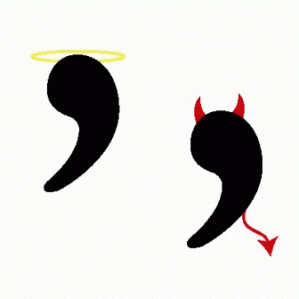I’ve read the articles, I know the rules. Using two spaces after a hard stop is apparently archaic and drives graphic designers up the wall. I hate to argue against this trend, as I’m sure it tends to make me look either ignorant or stubborn, but I have good reason for choosing to continue using two spaces.
To start off, I understand that modern types have much more advanced kerning than the days of the typewriter. I have never used a typewriter as a serious implement of typing, so I am not necessarily falling back on old, fixed-space habits. In the days of the typewriter, two spaces made it clearer where a sentence began or ended, and I think that still holds true. For the purposes of automation, punctuation is certainly more easily interpreted with two spaces, and for the purposes of clarity, two spaces resolves even the most obscure situation where a hard stop might be unclear (such as a sentence that includes a period followed by a capitalized word that does not indicate the start of a new sentence.) The double space simply allows for better readability, clarity, and the all-important quality of being easily browsed.
The aesthetics of spacing seems to be at the heart of this debate, and I have always supported the idea that aesthetics is relative. Readers tend to skip over spaces when reading, so one or the other is not going to be detrimental to the function of reading. Most html compilers remove the second space to compress whitespace (the web is not taking a side, it is merely following certain protocols), so readers obviously function just fine without the second space.
And my related but tangential second topic, is the serial comma. The main argument against the serial comma is that it can create ambiguity and is truly redundant. I think a good argument is put forward and the votes for its use (including Chicago Manual of Style, the US Government Style Manual, and the Oxford Style Manual) are neatly balanced by the votes against its use (including the AP Stylebook, the New York Times stylebook, and the Oxford Writing and Style Guide, apparently differing with the Oxford Style Manual.) The Economist style manual makes a nice compromise, saying it should only be used when it resolves ambiguity (such as when I refer to my blogposts about social media, commas and spaces, and whatever else.)
I do not intend to resolve this seemingly age old schism in the typed world, but I am putting my vote in for using the serial comma. For my style of writing and reading, it seems quite a bit more relevant to clearly delineate boundaries in a sequence than it does to avoid one extra dash. It does indeed limit the ability to make parenthetical comments in a sequence, but I have run into many situations such as that limitation in my writing, and I tend to always find a better way (usually by switching the elements in the sequence and making the parenthetical description on the second item. Then there is no ambiguity.) So, call me what you will, I am an Oxford-comma using, two-spaced writer. I’m sorry to the half of my teachers, employees, and colleagues that disagree with me; and to the other half, well, there you have it.
Of course, the reality is, I will use whatever style my client or brand requires.

